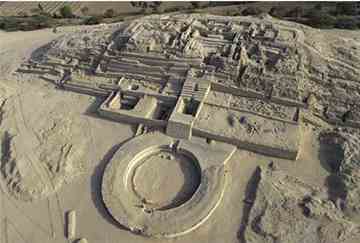Together with China, India, Egypt, Iraq and Mesoamerica, Peru forged the “cradles of civilization”, the first recognizably urban areas in world history. The photo below (which, although in colour, seems mainly grey reflecting the desert materials of the site in the early morning light) shows the main pyramid and amphitheater, just one part of the complex of constructions (including six truncated, terraced, pyramid platforms) at Caral in the Norte Chico area some 180 kilometers to the north of Lima.
 In this part of the special History of Peru series for the Peruvian Times we ask why, when and where did humans first settle in towns and cities in what is now Peru? Was it for security in war or to specialize in trade? Was it mainly all happening around 3000 BC? And why did this take place in the Norte Chico area?
In this part of the special History of Peru series for the Peruvian Times we ask why, when and where did humans first settle in towns and cities in what is now Peru? Was it for security in war or to specialize in trade? Was it mainly all happening around 3000 BC? And why did this take place in the Norte Chico area?
In short, how did early-Peruvians move from a simple nomadic life to forming more complex societies, congregating into urban or semi-urban areas?
Caral stood out as a clear candidate for inclusion in our series not least because it forms part of a greater “complex of formative towns and archaeological sites” (the whole Norte Chico zone) but also because of its current high-standing in the popular imagination.
At the site with the competent guide provided by the Caral-Supe project – which trains locals to be amiable, interested as well as interesting commentators as they walk you round – an hour or so is enough to provide an intelligent understanding of Caral’s history. (Bring a wide brimmed sun-hat and comfortable shoes.) Manuel, our guide, was immensely proud of his ancient ancestral heritage and did come from the nearby village of Caral.
Taken as a whole, the zone provides dateable materials stretching even further back than 5,000 years ago. Caral has produced little evidence that people at that stage formed towns or extended settlements as protection against attack, but plenty of evidence of economic specialization and hence exchange and trade (for example making fishing-nets in exchange for fish) associated with unusually long periods of peace.
They had “early khipus” (well, at least one – the khipu or quipu was a pre-hispanic knotted-string recording device) which could have provided the basis for an accounting system. In Sumeria about the same time the world’s first writing was, indeed, coming on stream using clay tablets but ceramics was not a technique available in Peru until about 1,800 BC thus impeding the easy development of writing. On the other hand writing in Sumeria seems to have been used mainly for “book-keeping”.
Author: Paul Goulder | Source: Peruvian Times [June 23, 2010]





